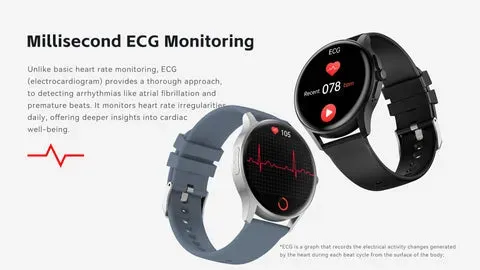The Rollme Hero R1 smartwatch has recently hit the market, boasting features such as ECG and non-invasive blood glucose monitoring. As with any tech product, it's essential to scrutinize the details before making a purchase decision.
Rollme, a China-based company, has been actively releasing health-tracking wearables, and the Hero R1 is positioned as a budget-friendly option. Let's delve into the specifications, features, and potential concerns associated with this smartwatch.
Display: A Glimpse at the Screen
The Hero R1 comes with a 1.39-inch touchscreen, offering a resolution of 360x360 pixels. Comparatively smaller than the Hero M5, which sports a 1.43-inch AMOLED display, the R1 provides users with the flexibility to adjust brightness up to 450 nits. Additionally, there are over 100 watch faces to cater to diverse styles and preferences.
While the display seems decent for the price, potential buyers should weigh the trade-offs between screen size and resolution, especially when compared to other models in the market.
Health Monitoring Features: Alleged ECG and Blood Glucose Measurement
The standout features of the Hero R1 include an ECG sensor for early detection of conditions like atrial fibrillation. The product page also claims the ability to track heart rate, blood oxygen saturation, temperature, and blood pressure. One notable addition is the alleged non-invasive blood glucose measurement, supported by an algorithm to analyze the collected data.
However, it's crucial to highlight that the Hero R1 is not certified for medical use, raising questions about the accuracy and reliability of its various health sensors. Potential buyers should approach these health-related features with caution and consider seeking professional advice if medical accuracy is a priority.
Battery Life: Balancing Act
Powered by a 280 mAh battery, the Hero R1 is claimed to offer up to 15 days of standby time or seven days with heavy use. While the battery life appears satisfactory, it's essential to validate these claims through real-world usage scenarios. Battery performance can significantly impact the overall user experience, making it a critical factor for potential buyers to consider.
Exercise Tracking and Connectivity: Staying Active
Similar to its counterpart, the Hero M5, the R1 features exercise tracking across various sports modes. This functionality caters to fitness enthusiasts, offering insights into their workout routines. Additionally, the smartwatch supports Bluetooth calling when connected to a phone, enhancing its utility beyond health monitoring.
While exercise tracking and Bluetooth calling are valuable features, users should assess their importance in the context of their individual needs and preferences.
Design and Price: Making a Statement
The Hero R1 is available in multiple colorways, including black/gold, silver, and gold, allowing users to express their style. However, the reduced price of $34.99 (compared to the regular $79.99) might be a double-edged sword. While the affordability is undoubtedly appealing, potential buyers should be cautious about potential compromises in build quality and overall durability.
Considerations and Warnings: Caveats Before Purchase
Before jumping in to buy the Rollme R1 Blood Glucose ECG smartwatch, it's crucial to consider a couple of red flags associated with the brand. Notably, there's no provided address for returns, and the customer service email appears more personal than professional. These aspects could impact the post-purchase experience and warrant careful consideration.
If your primary requirement is a smartwatch with ECG functionality, alternatives like the Garmin Fenix 7 Pro might be worth exploring, especially for users prioritizing brand reputation and customer service.
Conclusion: Weighing the Pros and Cons
The Rollme Hero R1 smartwatch presents an enticing package with alleged health-monitoring features at an affordable price point. However, potential buyers are advised to balance the allure of these features with critical considerations such as display quality, health sensor accuracy, battery life, and brand reliability. By thoroughly evaluating these factors, users can make an informed decision that aligns with their expectations and preferences.

